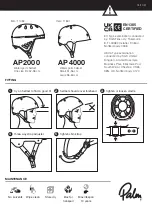
5 SEQUENCE INSTRUCTIONS
5.6 Termination Instructions
213
5
Ending the sequence program
END
This instruction indicates the end of a program.
■
Execution condition
Processing details
• This instruction indicates the end of a program including a main routine program, subroutine programs, and interrupt
programs.
• When the instruction is executed, the CPU module terminates the running program.
• If END processing is required in the middle of a program, use the FEND instruction.
• If the program is created using the engineering tool (in ladder edit mode), the END instruction is automatically input and
cannot be edited.
• The following figure shows how to use the termination instructions when a main routine program, subroutine program, and
interrupt program exist.
Ladder
ST
Not supported
FBD/LD
Not supported
Instruction
Execution condition
END
Every scan
A: Main routine program
B: Subroutine program
C: Interrupt program
D: Main sequence program area
(1) The FEND instruction is required.
(2) The END instruction is required.
RnCPU RnENCPU
RnSFCPU RnSFCPU
RnPCPU
RnPCPU
(Standard)
(Safety)
(Redundant)
(Process)
END
0
Program
FEND
END
A
C
D
B
(1)
(2)
Summary of Contents for MELSEC iQ-R Series
Page 1: ...MELSEC iQ R Programming Manual Instructions Standard Functions Function Blocks ...
Page 2: ......
Page 24: ...22 INDEX 2092 INSTRUCTION INDEX 2093 REVISIONS 2104 WARRANTY 2105 TRADEMARKS 2106 ...
Page 34: ...32 MEMO ...
Page 35: ...33 PART 1 PART 1 OVERVIEW This part consists of the following chapter 1 OVERVIEW ...
Page 68: ...66 1 OVERVIEW 1 5 Precautions on Programming MEMO ...
Page 1448: ...1446 14 REDUNDANT SYSTEM INSTRUCTIONS 14 2 Disabling Enabling System Switching MEMO ...
Page 1972: ...1970 33 TIME DATA TYPE FUNCTIONS 33 4 Division MEMO ...
Page 2067: ...APPX Appendix 5 PID Control Program Examples 2065 A 252 Set PID control data for loop 2 ...
Page 2109: ......
















































